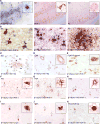Validating novel tau positron emission tomography tracer [F-18]-AV-1451 (T807) on postmortem brain tissue
- PMID: 26344059
- PMCID: PMC4900162
- DOI: 10.1002/ana.24517
Validating novel tau positron emission tomography tracer [F-18]-AV-1451 (T807) on postmortem brain tissue
Abstract
Objective: To examine region- and substrate-specific autoradiographic and in vitro binding patterns of positron emission tomography tracer [F-18]-AV-1451 (previously known as T807), tailored to allow in vivo detection of paired helical filament-tau-containing lesions, and to determine whether there is off-target binding to other amyloid/non-amyloid proteins.
Methods: We applied [F-18]-AV-1451 phosphor screen autoradiography, [F-18]-AV-1451 nuclear emulsion autoradiography, and [H-3]-AV-1451 in vitro binding assays to the study of postmortem samples from patients with a definite pathological diagnosis of Alzheimer disease, frontotemporal lobar degeneration-tau, frontotemporal lobar degeneration-transactive response DNA binding protein 43 (TDP-43), progressive supranuclear palsy, corticobasal degeneration, dementia with Lewy bodies, multiple system atrophy, cerebral amyloid angiopathy and elderly controls free of pathology.
Results: Our data suggest that [F-18]-AV-1451 strongly binds to tau lesions primarily made of paired helical filaments in Alzheimer brains (eg, intraneuronal and extraneuronal tangles and dystrophic neurites), but does not seem to bind to a significant extent to neuronal and glial inclusions mainly composed of straight tau filaments in non-Alzheimer tauopathy brains or to lesions containing β-amyloid, α-synuclein, or TDP-43. [F-18]-AV-1451 off-target binding to neuromelanin- and melanin-containing cells and, to a lesser extent, to brain hemorrhagic lesions was identified.
Interpretation: Our data suggest that [F-18]-AV-1451 holds promise as a surrogate marker for the detection of brain tau pathology in the form of tangles and paired helical filament-tau-containing neurites in Alzheimer brains but also point to its relatively lower affinity for lesions primarily made of straight tau filaments in non-Alzheimer tauopathy cases and to the existence of some [F-18]-AV-1451 off-target binding. These findings provide important insights for interpreting in vivo patterns of [F-18]-AV-1451 retention.
© 2015 American Neurological Association.
Conflict of interest statement
Potential conflict of interest:
MM, MN, CV, IC, EB, LR, WK, CM, MI, MD, BD, SG, JG, MP, TGI have no conflicts of interest.
NV has a patent called “Improved Radiosynthesis of The Tau Imaging Radiopharmaceutical [18F]AV-1451” (PCT/US2014/040165) pending. AV-1451 is the PET compound used in this study.
KJ reports grants from Eli Lilly and Company during the conduct of the study. Eli Lilly and Company owns Avid, the company that created AV-1451, the PET compound used in this study.
BH reports personal fees from Eli Lilly and Company outside the submitted work. Eli Lilly and Company owns Avid, the company that created AV-1451, the PET compound used in this study.
Figures




References
-
- Xia CF, Arteaga J, Chen G, et al. [(18)F] T807, a novel tau positron emission tomography imaging agent for Alzheimer’s disease. Alzheimer’s & dementia: the journal of the Alzheimer’s Association. 2013 Nov;9(6):666–76. - PubMed
-
- Zhang W, Arteaga J, Cashion DK, et al. A highly selective and specific PET tracer for imaging of tau pathologies. Journal of Alzheimer’s disease: JAD. 2012;31(3):601–12. - PubMed
-
- Chien DT, Bahri S, Szardenings AK, et al. Early clinical PET imaging results with the novel PHF-tau radioligand [F-18]-T807. Journal of Alzheimer’s disease: JAD. 2013 Jan 1;34(2):457–68. - PubMed
-
- Hauw JJ, Daniel SE, Dickson D, et al. Preliminary NINDS neuropathologic criteria for Steele-Richardson-Olszewski syndrome (progressive supranuclear palsy) Neurology. 1994 Nov;44(11):2015–9. - PubMed
Publication types
MeSH terms
Substances
Grants and funding
- P01 AG036694/AG/NIA NIH HHS/United States
- U01 NS086659/NS/NINDS NIH HHS/United States
- P50 AG005134/AG/NIA NIH HHS/United States
- P01 AG014449/AG/NIA NIH HHS/United States
- P50 AG005133/AG/NIA NIH HHS/United States
- AG005133/AG/NIA NIH HHS/United States
- P01 AG025204/AG/NIA NIH HHS/United States
- R34 AG049647/AG/NIA NIH HHS/United States
- R01MH100350/MH/NIMH NIH HHS/United States
- AG005134/AG/NIA NIH HHS/United States
- U01NS086659/NS/NINDS NIH HHS/United States
- R01 MH100350/MH/NIMH NIH HHS/United States
- AG014449/AG/NIA NIH HHS/United States
- AG036694/AG/NIA NIH HHS/United States
- AG025204/AG/NIA NIH HHS/United States
LinkOut - more resources
Full Text Sources
Other Literature Sources

